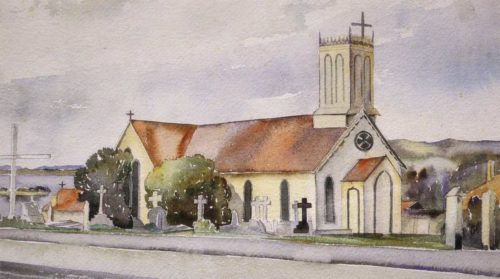
We continue our series by historian Alan La Roche celebrating the 170th anniversary of the Howick region, a stepping stone to the 175th anniversary celebrations.
Compulsory church attendance every Sunday for Fencible [soldier-settlers], their wives and children, was enforced on the voyage from Britain and during their seven year military term in Howick, Panmure, Otahuhu and Onehunga Fencible settlements.
The extremely harsh and cruel penalties for not attending church muster and church services every Sunday were unfair. If a Fencible missed attending two Sunday musters, he would lose his cottage, his acre of land, and repay the passage money for his wife, children and himself all taken out of his pension fund which the officers controlled. No income, no pension money, no house or land sent many to the debtors’ prison- all for not attending church twice!
It is said that about 50 Fencibles in Howick lost their cottage for not attending church on Sundays or similar missed deeds. Most of those who missed the church muster were Anglicans. Those of the Catholic faith were more contentious and attended regularly.
These battle-weary retired old soldiers with about 20 years of military discipline now had to work a 60-hour, six days a week building roads looked forward to a “day of rest” to talk to their wives and children, work in their vegetable gardens but, instead, half of Sunday was attending the church muster under officers, some of whom were half their age who had bought their commissions, and were of a different “social class”. A sickness certificate was often not accepted by the young officers.
In 1848, the Anglican Bishop of New Zealand, Bishop George Augustus Selwyn said “the duty of spiritual hospitality was performed and we set our hearts upon receiving them on landing with the House of God prepared for their reception”.
The church was being prepared for St Stephens School in Parnell, at St Johns College, Kohimarama. When about 800 new immigrants arrived in November 1848 in Howick, their need was greater. The timbers were carried by the college vessels Undine and Marian to Waipaparoa-Howick Beach, where some local farmers with oxen and carts hauled the timbers up the Selwyn Road ridge to the knoll overlooking the bay.
The frame of All Saints Church was put up ready for the first Sunday after arrival on November 21, 1847, although parishioners were wet from a passing shower as they sat on bundles of shingles, as there was no roof. Within a few weeks, the church in the shape of a cross was completed. Bishop Selwyn was disappointed that popular “Shamrock Cottage” grog shop, then called “The Royal Hotel” was the second building completed in Howick.
The Catholic former Marist missionary Father Antoine Garin arrived in Howick on January 2, 1848 appointed by Bishop Pompallier and Bishop Phillippe Viard. All these churchmen came from France. Most of the Howick Catholics came from Ireland and helped Fr Garin build a temporary school and chapel with many local Maori contributing. Garin was assisted with his parish work by two Maori from the Mangakohia mission in the Kaipara. Fr Garin lived in a crude raupo cottage presbytery built in 1849.
The wooden “Our Lady Star of the Sea” church was completed by February 1854. Fr Garin planted grapes for communion wine and he had poultry, a cow and a horse. His parish included Otahuhu, Panmure as well as Howick. Panmure and Otahuhu initially had a raupo school room and church until wooden more permanent buildings were built by 1852.
The little Methodist Church now in the Howick Historical Village was built in 1852 on Fencible Reserve in Picton Street. For several years, all Fencibles after the Church Muster were marched to the Catholic Church or to All Saints Anglican Church.
If you were a Methodist, Presbyterian or other religion, you attended with your church members in the evenings or on Sunday afternoon, and if you did not attend the Catholic or Anglican service, you had a route-march while the rest were in church.
In 1866, there were more Methodists in Pakuranga than Howick so it was moved onto Qualtrough’s farm in Pakuranga Road. The new Trinity Methodist Church was built in 1968 for a growing community.
Howick’s Presbyterian’s used a Fencible’s cottage initially in 1848 until their Kirk, Scotch or St Andrew’s Church, as they called it, opened in 1873.
The graveyard area was reserved for grazing horses and parking gigs while at Sunday church.
- Alan La Roche, Howick Historian







